If you ask a person which system is the most important in our body , will answer: "Circulatory"! Perhaps someone else gastrointestinal tract. And only a few will remember the lymphatic system. Of course , it's wonderful when all the systems of the body work smoothly and seem to be a single whole. But if we talk about which of them has a particularly strong effect on our health , even beauty , then first of all you need to think about the lymphatic system.
Curious facts about the lymphatic system
- If the lymph does not move through the body within 2 hours , then the functioning of the body becomes impossible.
- The number of lymphatic vessels is several times higher than the number of blood vessels.
- Lymph flow is much slower than blood flow. Even in the largest lymphatic vessels, fluid moves at less than 4 mm per second.
- In the body of an adult - 1.5-2 liters of lymph. This fluid is similar in properties to blood plasma and consists of water , salts , minerals , colloidal solutions of proteins , fats and lymphocytes.
- Lymphocytes are cells of the immune system. Want to boost your immunity? Take care of your lymphatic system first!
- Lymph only moves in one direction , unlike blood.
- There is no "pump" in the lymphatic system, as in the circulatory system ( there is a heart there). The movement is provided only by a combination of several factors ( about them - in a separate paragraph).
- There are about 500 lymph nodes in the human body!
Basic information about the lymphatic system
The lymphatic system is designed to cleanse the body. Blood transports necessary oxygen and nutrients to organs and tissues. And the lymph takes everything that is used and toxic into the excretory system , plus it destroys bacteria and foreign bodies.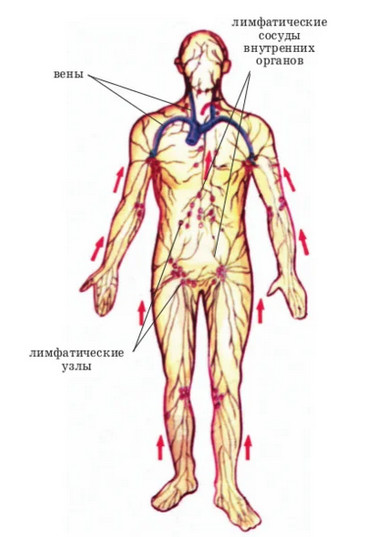
The lymphatic system consists of:
- Organs. These include the bone marrow ( creates blood and stem cells), the spleen ( produces antibodies to fight foreign bodies), the thymus gland ( takes stem cells and turns them into T-lymphocytes that fight malignant cells).
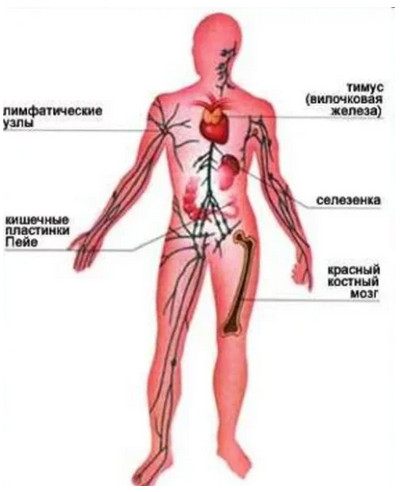
- capillaries.
They form an extensive network in the tissues and are designed to collect fluid. Vessels. Capillaries merge into them. The walls of the lymphatic vessels are quite thin. And the movement of the fluid goes only in one direction: from the periphery to the center. To prevent retrograde ( reverse) lymph flow , the vessels are equipped with valves. - Vessels entangle every organ in our body like a network. Some organs have several layers of such networks.
- Lymph nodes. In them, the vessels deliver everything that the lymphatic capillaries have collected together with the waste fluid. I liked how one article wrote that the lymph nodes are located at "the busiest intersections." Look , for example , where they are on the neck / face.
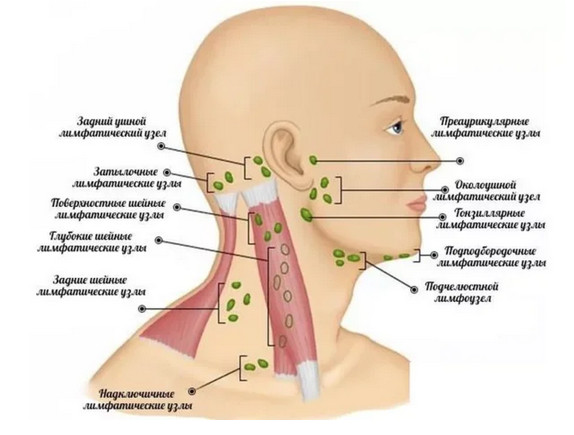
And this is the location of the lymph nodes in the body: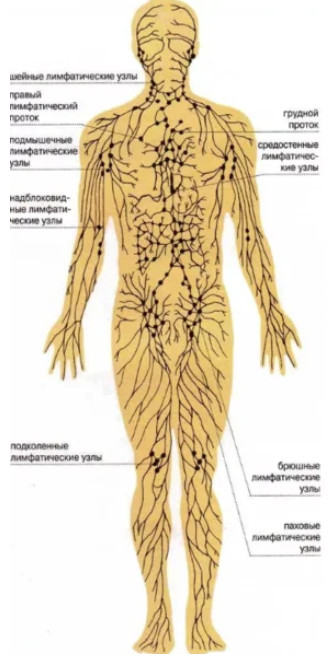
From the lymph nodes, lymph moves from the right half of the body - to the right lymphatic duct , and from the left - respectively , to the left. Both ducts flow into the general blood stream. It occurs at the confluence of the subclavian and jugular veins.
Functions of the lymphatic system: 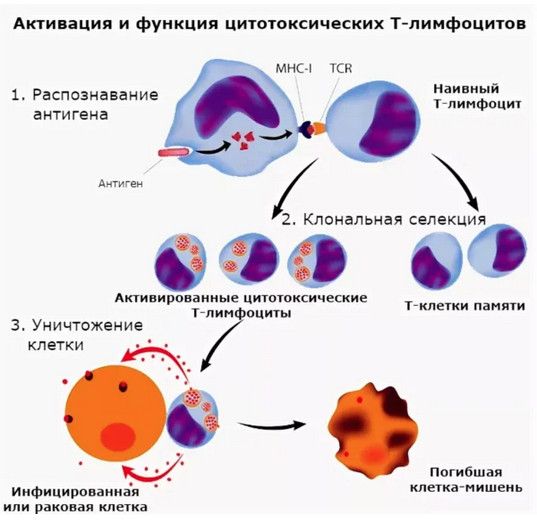
- Filters: retains mechanical impurities , neutralizes bacteria and viruses. Their destruction occurs in the lymph nodes with the help of lymphocytes. Already purified blood enters the veins.
- Returns proteins and electrolytes to the blood. It also transports fats from the intestines and many other nutrients. This is possible due to the fact that lymphatic capillaries have a larger diameter and thinner walls ( compared to blood capillaries). As a result, proteins and other valuable components enter the lymphatic system directly from the interstitial space.
- Removes foreign bodies , red blood cells and decay products into the excretory system. , enter the lymph .
- Produces lymphocytes and antibodies. Transports immune cells throughout the body.
- drainage function. The lymphatic system removes excess water and salt from the tissues.
- Lymphatic system. What does it affect
Depends on her condition:
- Immunity. If you often get sick , then with a high degree of probability the reason is in the lymphatic system.

- Weight. Here the connection is direct: firstly , excess fluid accumulates in the body. Secondly , a weak outflow of lymph slows down the metabolism.
- Tendency to edema. This is especially noticeable on the lower extremities: it is there that most fluid accumulates under the influence of gravity. Also, swelling appears on the face: the oval becomes blurry , there are “bags” under the eyes, the second chin comes out , the face looks puffy.
- Inflammatory processes in the skin. For example , acne , acne is one of the signs of a dysfunctional lymphatic system. You can clean the top layer of the skin as much as you like , but if the decay products from the tissues do not leave through the lymphatic capillaries , then the problem will remain in place.
- Enlarged lymph nodes. I will not talk about diseases of the lymphatic system , because. this does not fit into the concept of my channel and is generally within the competence of doctors. Let me just say that for our family this topic is very painful and relevant. My mother-in-law currently has lymphoma. This is an oncological disease. He is currently undergoing a very painful and lengthy treatment. I would never wish anyone to experience this! Take care of your lymphatic system and be healthy!
How does lymph move
- Before looking at the ways to "accelerate the lymph", it is worth understanding what makes it move.
- As I wrote above: we do not have a motor like the heart for the lymphatic system. Therefore, the movement of fluid in it is provided by a combination of several factors:
- contraction of the muscles of the body ( i.e. "muscle pump");
fluid pressure ( osmotic and hydrostatic), partly pressure fluctuations in the tissues depend on the pulsation of the arteries;
the valve system creates a suction effect of fluid from the tissues;
"suction" force of the chest during breathing;
the action of "lymphagons" ( capillary poisons increase the permeability of the walls , and there are also substances that enhance the filtration of fluid from the blood). - From all of the above, we can influence the "muscle pump", breathing technique and help the valves do their job.
How to do it?
How to disperse the lymph 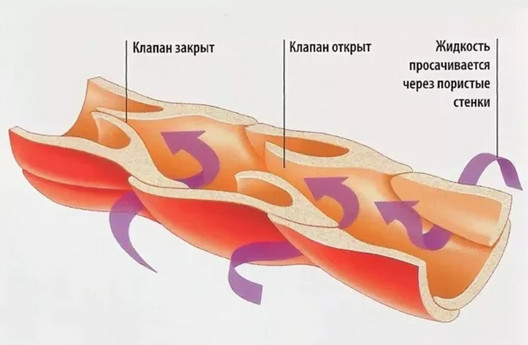
If you carefully read the article , then you already understand: "acceleration of the lymph" - this is very loudly said. There are no high speeds in the lymphatic system at all. However, we can quite cope with such a phenomenon as a slow outflow of lymph and stagnation of excess fluid in the tissues.
Balanced diet. 
First of all, it is worth including more foods rich in fiber ( vegetables , cereals) in your diet. , white bread , meat and dairy products as possible ( with the exception of sour-milk products - they are useful and necessary , especially for the female body).
Salads of red cabbage and fresh beets , parsley , fresh garlic , lettuce , linseed oil and seaweed are highly recommended.
Herbal teas from nettle , clover , and elderberry are also useful for the lymphatic system. 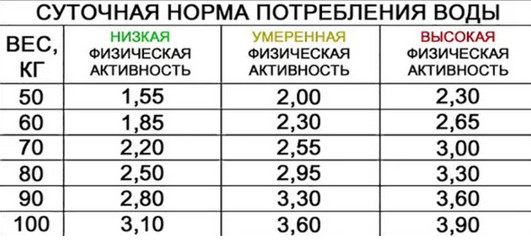 Of the spices, ginger and turmeric are effective.
Of the spices, ginger and turmeric are effective.
Drinking balance.
It is a big delusion to think that if edema appears , you need to practically stop drinking altogether. You can limit your fluid intake , but in general, the body will still need water to move the lymph!
I don’t know where the generalized figure came from that everyone needs to drink 2 liters of fluid per day! Is it possible to equalize everyone with the same brush? Of course not ! The recommended amount of water consumed: 30 ml per 1 kg of body weight. That is, a person with a weight of 50 kg is enough 1.5 liters per day. In addition , you need to take into account the season , the intensity of life.
Save so you don't lose
